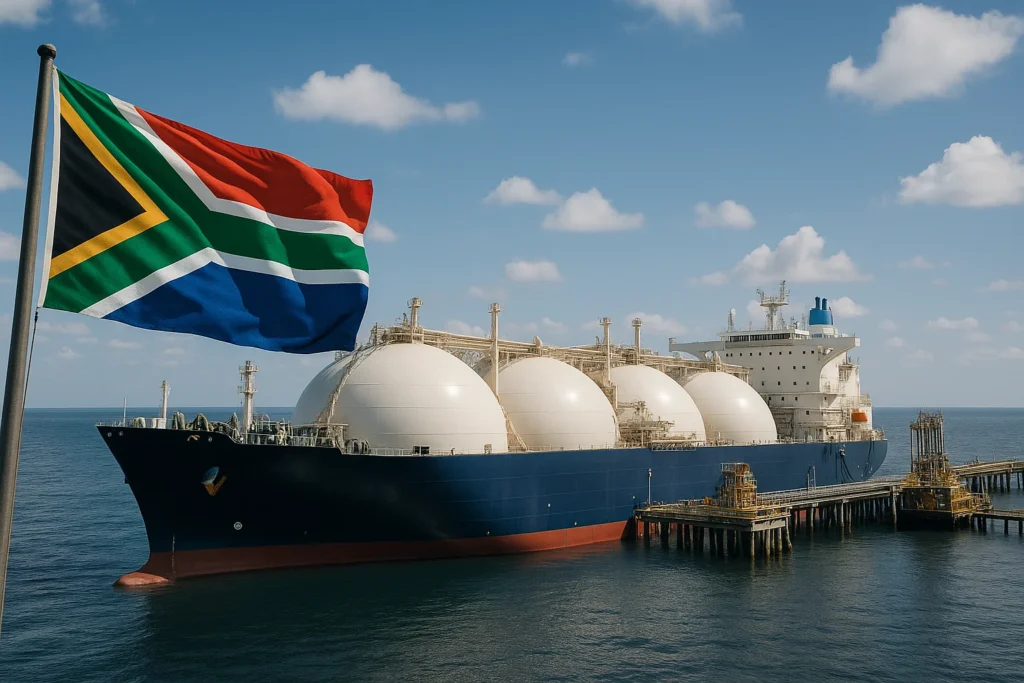Prologue: The Midnight Negotiation
The hum of backup generators filled the windowless basement conference room of Pretoria’s Sheraton Hotel as South Africa’s Energy Minister Gwede Mantashe paced nervously. Outside, another stage 6 load-shedding blackout plunged the capital into darkness—the twelfth such outage that week. On the flickering video screen, U.S. Energy Secretary Jennifer Granholm’s face appeared pixelated as the teams raced against both time and Eskom’s failing power grid to finalize what could become Africa’s largest liquefied natural gas (LNG) deal.
“We’re not just negotiating energy supplies,” Mantashe growled, wiping sweat from his brow despite the room’s chill. “We’re negotiating South Africa’s ability to keep its hospitals running and factories operating while we rebuild our entire energy future.”
The proposed $12 billion agreement for American LNG represents South Africa’s most dramatic energy pivot since the apartheid era—a complex high-wire act balancing climate commitments, economic survival, and geopolitical realignment that will shape the nation’s trajectory for decades.
Chapter 1: The Anatomy of a Transformational Deal
By the Numbers: What’s at Stake
✔ Annual Volume: 75–100 million cubic meters (enough to power 3.5 million homes or 15% of current coal generation)
✔ Contract Duration: 10-year supply commitment with optional 5-year extension
✔ Total Value: $8–12 billion depending on Henry Hub price fluctuations
✔ Delivery Timeline: First shipments expected Q3 2025 via newly expanded Saldanha Bay LNG terminal
✔ Job Creation: 8,000 temporary construction jobs, 1,200 permanent operations positions
Why American Gas? The Strategic Calculations
- Price Stability: Long-term Henry Hub pricing beats volatile Asian spot markets that have swung 300% in recent years
- Geopolitical Insurance: Reduces reliance on unstable Mozambican supply amid Islamist insurgency near critical gas fields
- Transition Advantage: When replacing coal, LNG cuts CO2 emissions by 50% and eliminates mercury/particulate pollution
- Infrastructure Synergy: Compatible with existing Eskom plants needing minimal retrofits
“This isn’t a fossil fuel addiction—it’s methadone while we kick coal. But we can’t stay on methadone forever.”
— Liziwe McDaid, Energy Analyst at EE Publishers
Chapter 2: Walking the Energy Tightrope
South Africa’s Energy Paradox
The nation faces intersecting crises:
The Coal Collapse
- 80% of power still comes from aging coal plants (average age 42 years)
- 14 major plants scheduled for decommissioning by 2030
- Maintenance backlog exceeds $25 billion
The Renewable Lag
- Despite world-class solar/wind resources, renewables constitute just 10% of grid
- Regulatory hurdles delay projects by 3–5 years on average
- Battery storage capacity remains woefully inadequate
The Mozambican Meltdown
- Islamist insurgency in Cabo Delgado has disrupted 30% of contracted gas supply
- Total production now at 40% of pre-conflict levels
- Repair timelines uncertain amid ongoing violence
The Transition Timeline: A Decade of Transformation
| Year | Key Milestone | Challenges |
|---|---|---|
| 2025 | LNG replaces 15% coal generation | Port infrastructure delays |
| 2027 | First new gas plants operational | Community protests over fracking |
| 2030 | Solar/wind overtake coal in new capacity | Grid stability concerns |
| 2035 | Gas phased down as renewables dominate | Stranded asset risks |
Chapter 3: The Ripple Effects Across Society
Domestic Winners & Losers
✔ Winners:
- Manufacturers: Reduced load-shedding could save auto/steel industries $300M monthly
- Port Cities: Saldanha Bay set to become Africa’s premier LNG hub
- Gas-Rich Regions: Northern Cape towns near new plants gaining jobs
✖ Losers:
- Coal Communities: 30,000 mining jobs at risk in Mpumalanga
- Environmental Justice Groups: Argue gas locks in emissions for decades
- Russian/Chinese Firms: Losing energy market share to Western companies
The Geopolitical Chessboard
- U.S. Strategic Gain: Foothold in African energy markets counters Chinese influence
- China’s Response: Accelerating Belt & Road renewable projects as counterplay
- EU Concerns: More competition for limited LNG supplies amid Russian cutoff
- African Ripple Effects: Namibia/Botswana watching as potential future clients
Chapter 4: Voices from the Frontlines
The Coal Miner’s Wife (Mpumalanga)
“They talk about ‘just transition’ while offering my husband a six-month welding course. His grandfather mined coal, his father mined coal—what’s left for our children when America’s gas comes?”
The Solar Entrepreneur (Cape Town)
“For three years, my factory has operated on diesel generators. Finally, reliable power to scale production while we build the renewable future. LNG isn’t the destination—it’s the bridge.”
The Climate Activist (Durban)
“Every rand spent on gas infrastructure is stolen from wind farms and solar plants. This isn’t transition—it’s arsonists selling us fire extinguishers.”
The Port Engineer (Saldanha Bay)
“We’re working triple shifts to expand the terminal. This isn’t just about offloading gas—it’s about rebuilding South Africa as an energy exporter.”
Epilogue: The Bridge or the Cliff?
As Mantashe’s pen hovered over the final agreement pages, the weight of history pressed down. The LNG deal would buy South Africa precious time—but whether that time would be used to leap toward renewables or stall in gas dependency remained the nation’s defining question. One truth had become undeniable: in the global energy transition, there are no easy choices, only calculated risks.
The lights flickered back on as Eskom restored power. The negotiators exchanged exhausted smiles. South Africa’s energy future, for better or worse, had just changed forever.
Is natural gas a necessary bridge or dangerous detour for developing nations’ energy transitions? Share your perspective. ⚡🔥




mkogoc